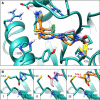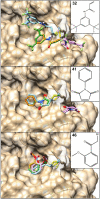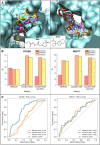WIDOCK: a reactive docking protocol for virtual screening of covalent inhibitors
- PMID: 33458809
- PMCID: PMC7904743
- DOI: 10.1007/s10822-020-00371-5
WIDOCK: a reactive docking protocol for virtual screening of covalent inhibitors
Abstract
Here we present WIDOCK, a virtual screening protocol that supports the selection of diverse electrophiles as covalent inhibitors by incorporating ligand reactivity towards cysteine residues into AutoDock4. WIDOCK applies the reactive docking method (Backus et al. in Nature 534:570-574, 2016) and extends it into a virtual screening tool by introducing facile experimental or computational parametrization and a ligand focused evaluation scheme together with a retrospective and prospective validation against various therapeutically relevant targets. Parameters accounting for ligand reactivity are derived from experimental reaction kinetic data or alternatively from computed reaction barriers. The performance of this docking protocol was first evaluated by investigating compound series with diverse warhead chemotypes against KRASG12C, MurA and cathepsin B. In addition, WIDOCK was challenged on larger electrophilic libraries screened against OTUB2 and NUDT7. These retrospective analyses showed high sensitivity in retrieving experimental actives, by also leading to superior ROC curves, AUC values and better enrichments than the standard covalent docking tool available in AutoDock4 when compound collections with diverse warheads were investigated. Finally, we applied WIDOCK for the prospective identification of covalent human MAO-A inhibitors acting via a new mechanism by binding to Cys323. The inhibitory activity of several predicted compounds was experimentally confirmed and the labelling of Cys323 was proved by subsequent MS/MS measurements. These findings demonstrate the usefulness of WIDOCK as a warhead-sensitive, covalent virtual screening protocol.
Keywords: Covalent docking; Covalent inhibitors; Virtual screening; Warhead reactivity.
Figures















Similar articles
-
Binding Mode Prediction and Virtual Screening Applications by Covalent Docking.Methods Mol Biol. 2021;2266:73-88. doi: 10.1007/978-1-0716-1209-5_4. Methods Mol Biol. 2021. PMID: 33759121
-
DUckCov: a Dynamic Undocking-Based Virtual Screening Protocol for Covalent Binders.ChemMedChem. 2019 May 17;14(10):1011-1021. doi: 10.1002/cmdc.201900078. Epub 2019 Mar 8. ChemMedChem. 2019. PMID: 30786178 Free PMC article.
-
A road map for prioritizing warheads for cysteine targeting covalent inhibitors.Eur J Med Chem. 2018 Dec 5;160:94-107. doi: 10.1016/j.ejmech.2018.10.010. Epub 2018 Oct 6. Eur J Med Chem. 2018. PMID: 30321804
-
Covalent Docking in Drug Discovery: Scope and Limitations.Curr Pharm Des. 2020;26(44):5684-5699. doi: 10.2174/1381612824999201105164942. Curr Pharm Des. 2020. PMID: 33155894 Review.
-
Arylfluorosulfate-Based Electrophiles for Covalent Protein Labeling: A New Addition to the Arsenal.Angew Chem Int Ed Engl. 2019 Jan 21;58(4):957-966. doi: 10.1002/anie.201806037. Epub 2018 Oct 26. Angew Chem Int Ed Engl. 2019. PMID: 30024079 Free PMC article. Review.
Cited by
-
Perspectives on Computational Enzyme Modeling: From Mechanisms to Design and Drug Development.ACS Omega. 2024 Feb 8;9(7):7393-7412. doi: 10.1021/acsomega.3c09084. eCollection 2024 Feb 20. ACS Omega. 2024. PMID: 38405524 Free PMC article. Review.
-
BIreactive: Expanding the Scope of Reactivity Predictions to Propynamides.Pharmaceuticals (Basel). 2023 Jan 12;16(1):116. doi: 10.3390/ph16010116. Pharmaceuticals (Basel). 2023. PMID: 36678612 Free PMC article.
-
Elucidating the functional impact of G137V and G144R variants in Maroteaux Lamy's Syndrome by Molecular Dynamics Simulation.Mol Divers. 2024 Aug;28(4):2049-2063. doi: 10.1007/s11030-023-10694-8. Epub 2023 Jul 17. Mol Divers. 2024. PMID: 37458922
-
Improvement of binding pose prediction of the MR1 covalent ligands by inclusion of simple pharmacophore constraints and structural waters in the docking process.3 Biotech. 2023 Aug;13(8):279. doi: 10.1007/s13205-023-03694-w. Epub 2023 Jul 19. 3 Biotech. 2023. PMID: 37483466 Free PMC article.
-
Virtual Screening and Dynamic Simulation of Baloxavir Derivatives for Multitarget Breast Cancer Treatment.Anticancer Agents Med Chem. 2025;25(16):1218-1238. doi: 10.2174/0118715206361014250307084057. Anticancer Agents Med Chem. 2025. PMID: 40108914
References
Publication types
MeSH terms
Substances
LinkOut - more resources
Full Text Sources
Other Literature Sources
Research Materials
Miscellaneous

